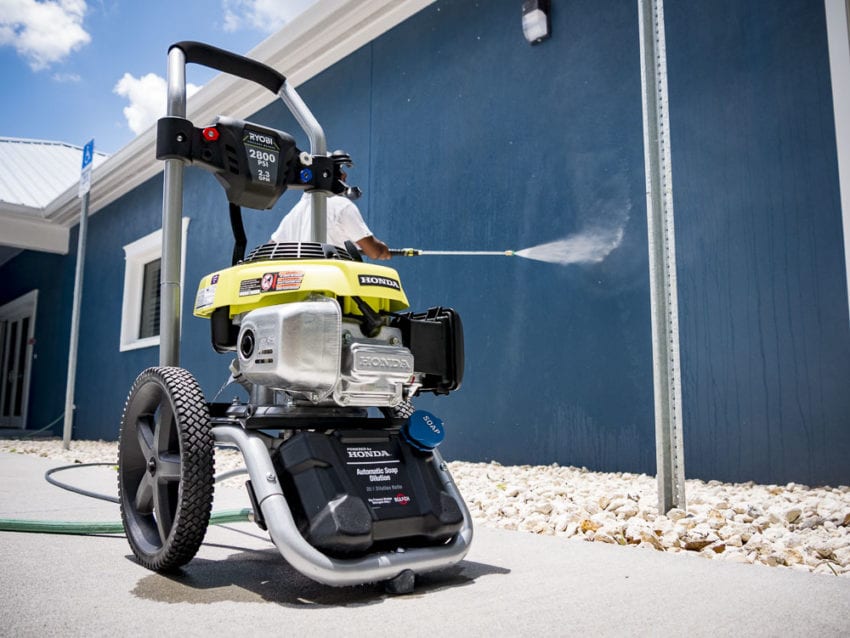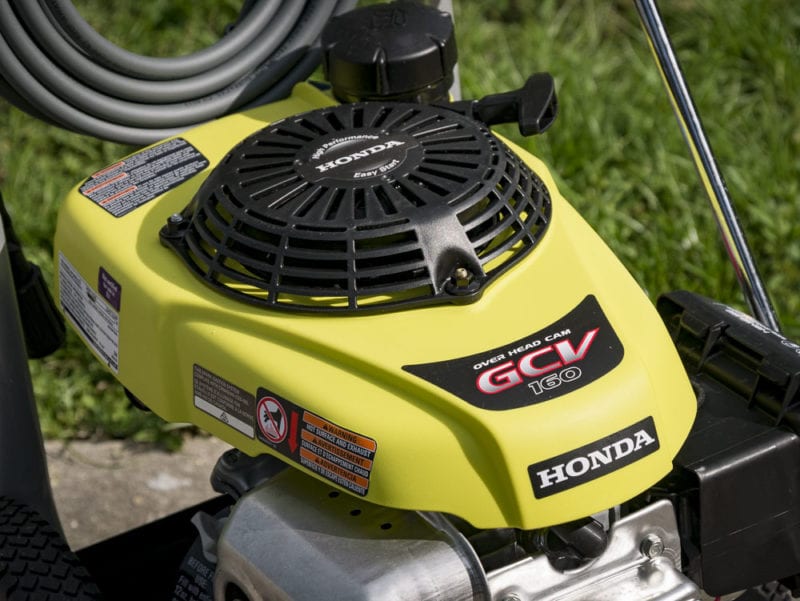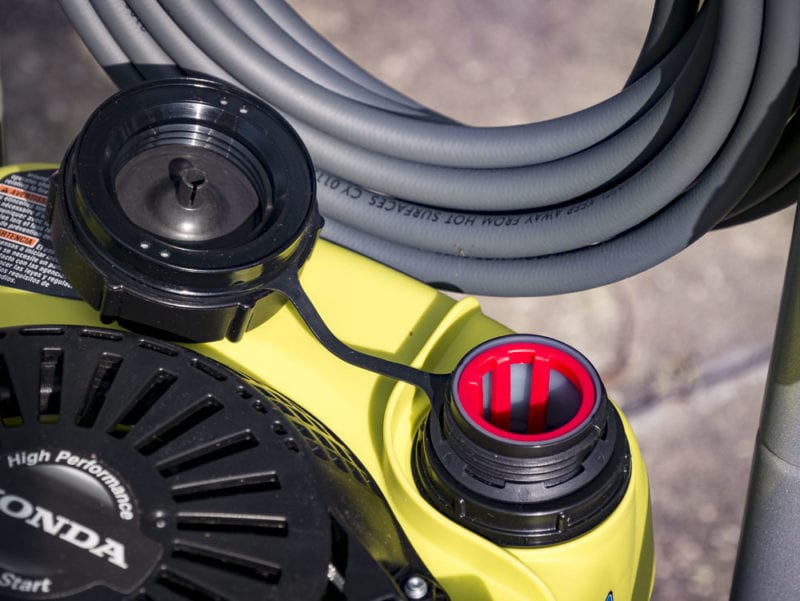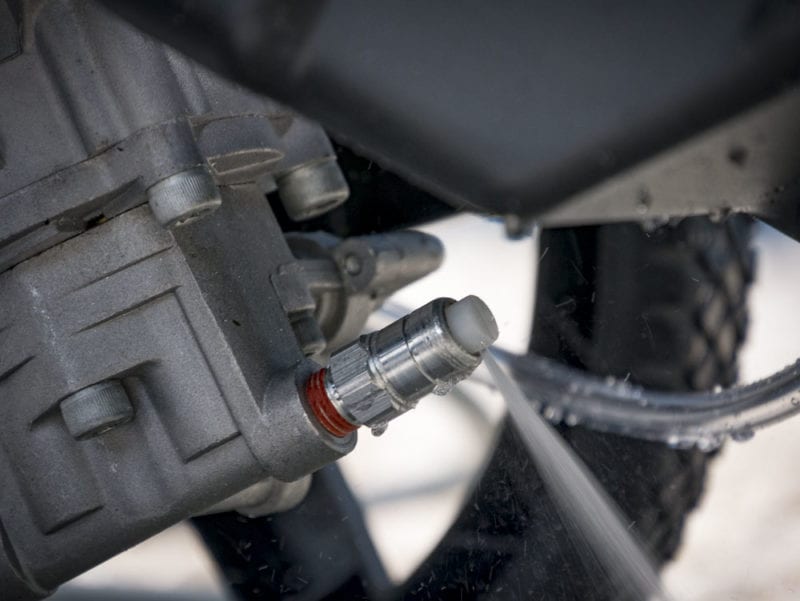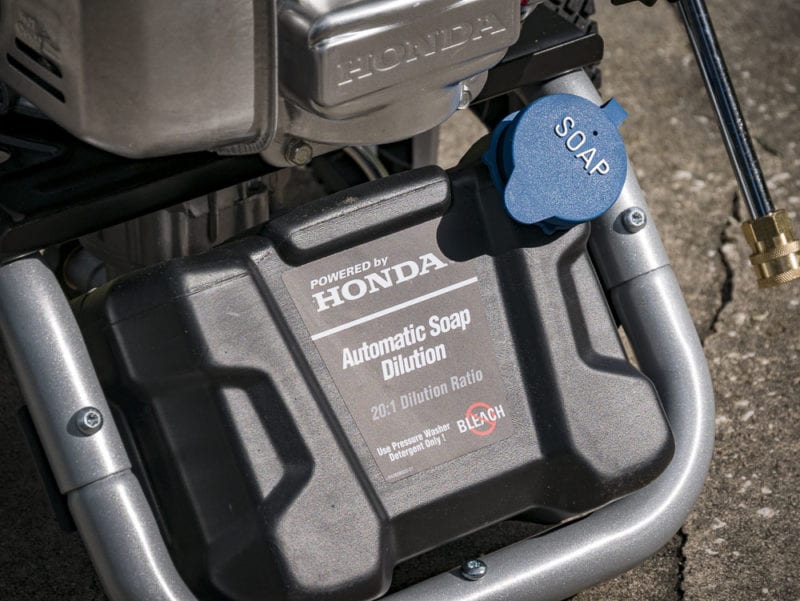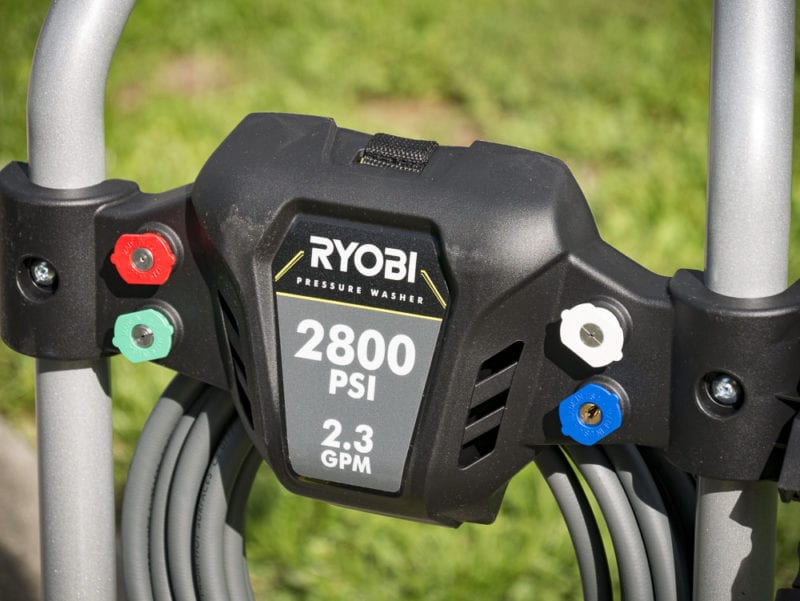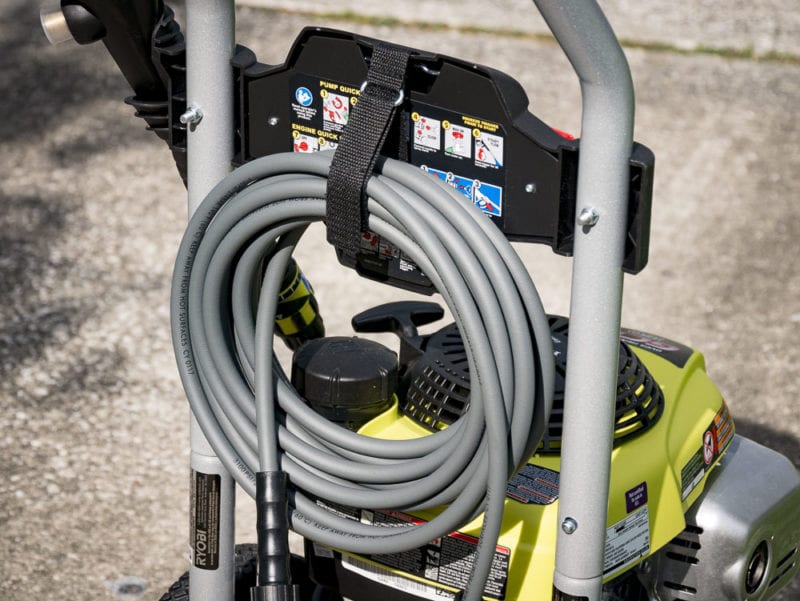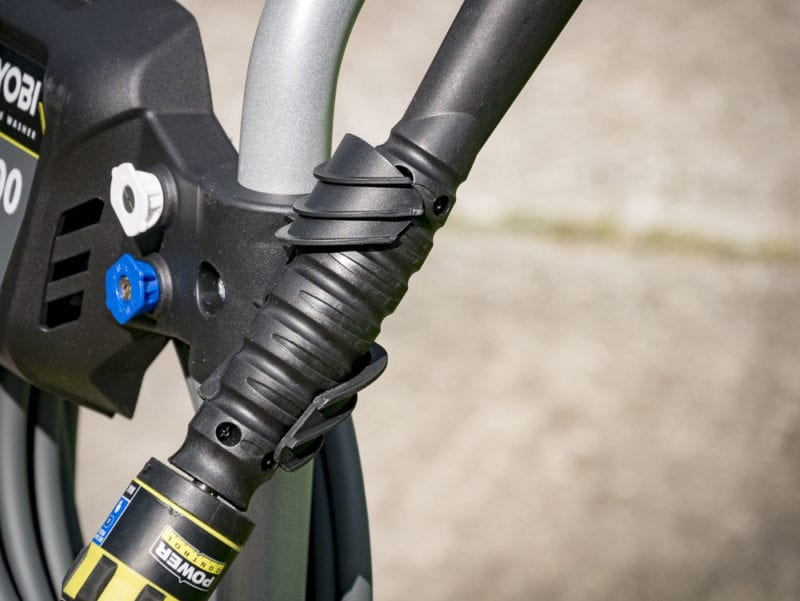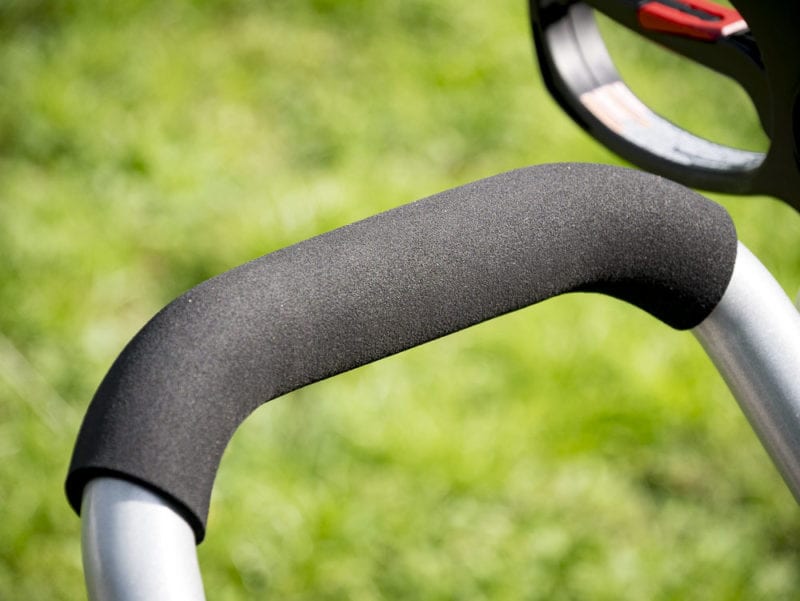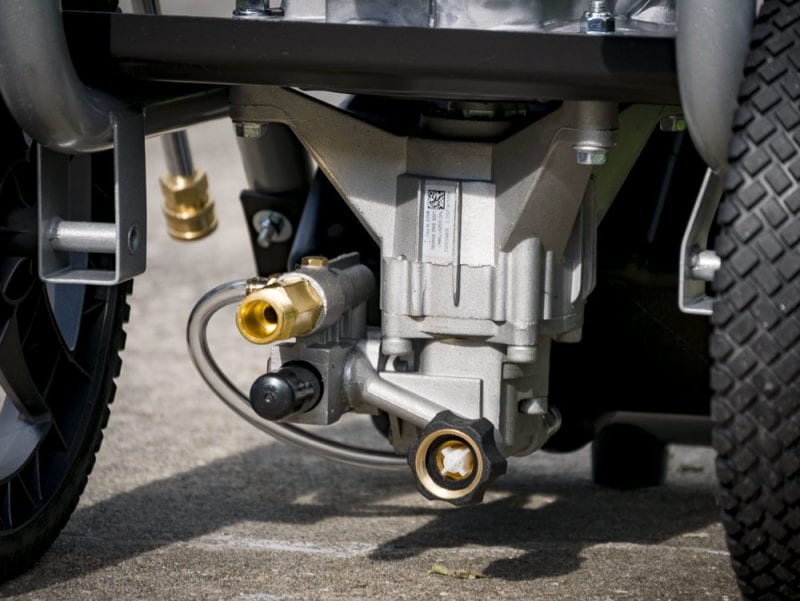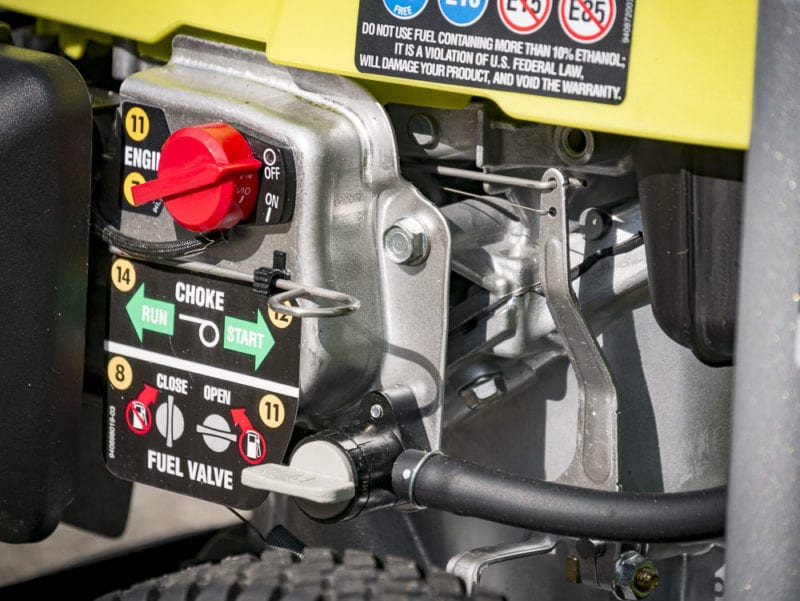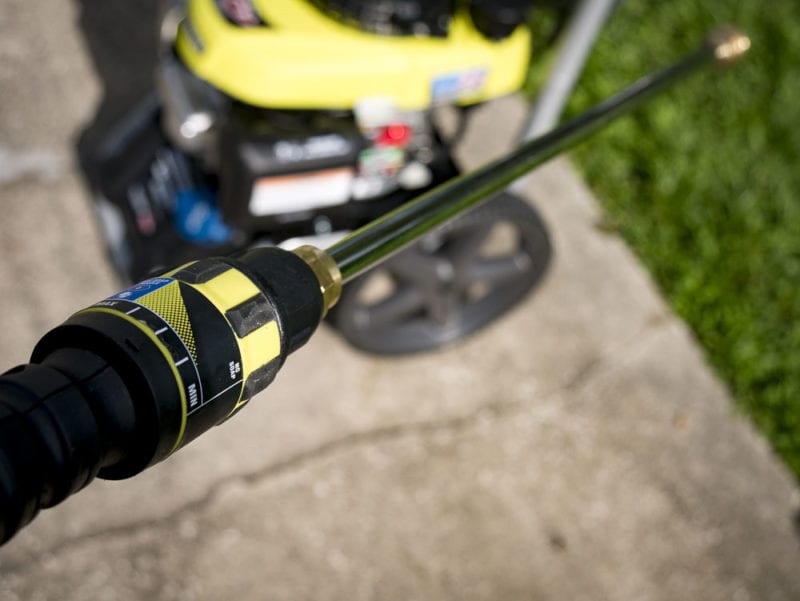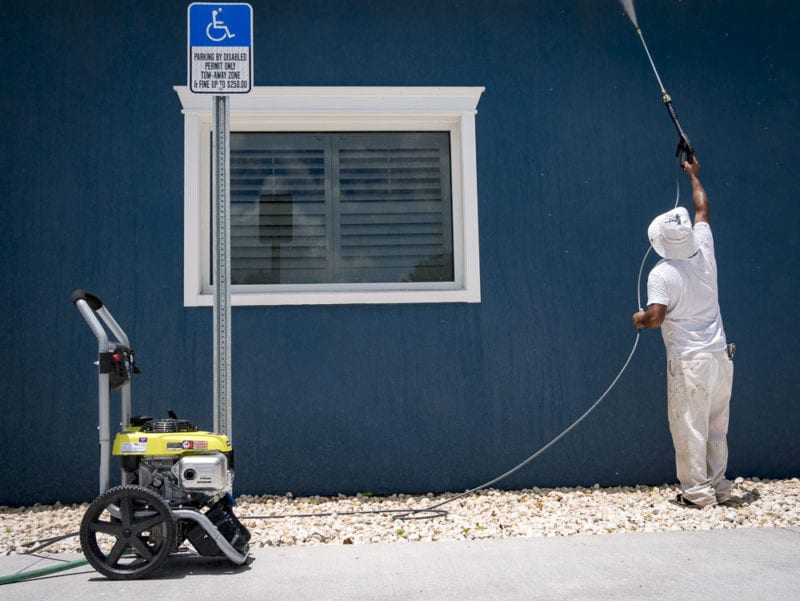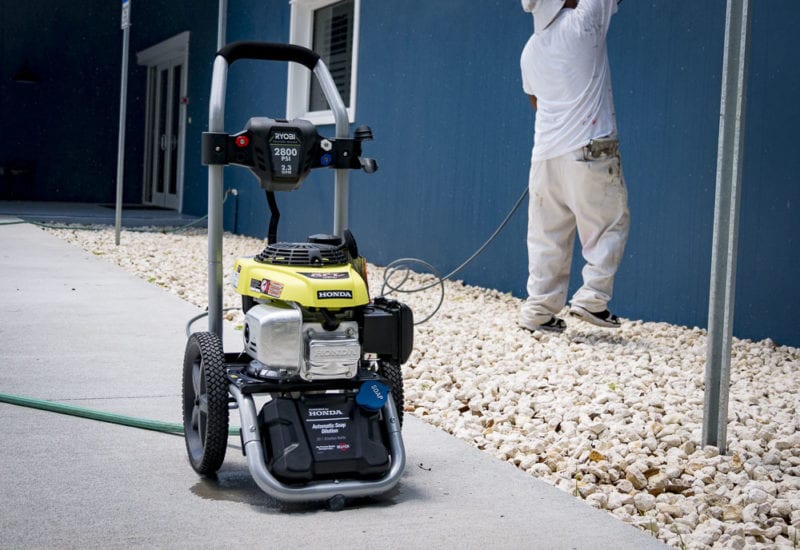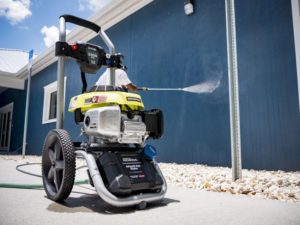With summer upon us, I got my hands on the Ryobi 2800 PSI Pressure Washer featuring a Honda GCV160 engine. The work on my plate was mainly light- to medium-duty, so 2800 PSI was enough power for what I was looking for. While not all Pros really consider Ryobi when looking for a pressure washer, it’s the Honda engine that gives me the confidence to pull the trigger.
I got together with Walt Benner, a career painter with talent and work that frequently extends beyond just painting to tackle a handful of tasks from homeowner needs to property maintenance. But before we even jump too far into this, let’s put the Ryobi RY802800 in its proper place.
Check out our best pressure washer article to see our top picks
Where the Ryobi RY802800 Fits
2800 PSI is not the peak when it comes to gas performance on a pressure washer. Pro commercial models can reach well over 4000 PSI. But it’s not only PSI you need to look at. There’s also how much water it delivers. Ryobi handles up to 2.3 gallons per minute (GPM), but Pro commercial models can push 4 GPM and even higher.
So this Ryobi 2800 PSI pressure washer fits in the middle to the upper end of medium-duty pressure washers. It’s going to be a solid performance level for cleaning patio furniture, siding, vehicles, and boats. You’ll also be able to handle cement surfaces like driveways and sidewalks. Getting away from some of the light-duty work, you can tackle wood applications like decking and fencing that sub-2000 PSI models struggle with.
Where you lose out in this category is in paint prep on building exteriors – something Pro painters like Walt have to keep in consideration.
Ryobi 2800 PSI Pressure Washer Key Features
Honda Engine
The Honda GCV160 engine is a key point of consideration for the Ryobi RY802800. Apart from the reliable reputation that Honda brings to OPE, the GCV160 is a 4-cycle engine, so you don’t need to mix the gas and oil. Just be sure to check your oil level before each use. It takes SAE 30 or SAE 10W30 oil that is readily available anywhere you shop for auto parts. The engine puts out 161 cc to produce that 2800 PSI pressure.
When it comes to fuel, avoid using e85 fuel, though you can use standard 10% ethanol gasoline. If you’re like me and have an ethanol-free fuel station nearby, paying the higher price for gas might extend the life of the engine, but it’s not a guarantee.
Pro Tip: Regularly use a pump protector to reduce hard water deposits and keep your seals and pistons lubricated. If at no other time, add it before winter storage. A fuel stabilizer is also a good idea before storage in the winter or if you’re using the pressure washer infrequently.
The motor can heat the water to a dangerous level, so there’s a release valve that will automatically reduce the pressure if it gets too high.
Axial Pump
Most pressure washers come with either an axial or triplex pump. Axial pumps are simpler, but triplex pumps tend to be more efficient and last longer. You’ll find triplex on most commercial level pressure washers because of that. Pros and property owners that use their pressure washer frequently will want to take note of the axial pump when considering this model. If you’re only going to use your pressure washer a couple of times a month or less, the axial pump you find isn’t a concern.
On-Board Detergent Tank
The detergent tank automatically mixes at a 20:1 ratio with water in a downstream fashion. According to the manual, you can convert it to an upstream mix, but you’ll need to contact customer service for more information on that.
There is a stern warning to only use detergents that carry a pressure washer-specific rating. There’s also a specific note not to use bleach – a favorite chemical of many Pros.
On-Board Accessory Storage
You’ll find that all your accessories have a home on board the pressure washer. Nozzles attach to the front. Behind those, you’ll find a handy guide for nozzle selection if you’re new to pressure washing. Ryobi includes four nozzles – 0, 25, and 40 degrees along with a soap nozzle.
The 25′ hose gets wrapped up and stored using a hook and loop strap. I don’t have a ton of confidence in the long term use of this, so I may task a bungee cord to the job in the near future. At least in these initial weeks of use, it’s still holding well, though.
The lance holder is another issue when it comes to storage. It holds the lance in place, but the plastic is weak enough that it often slips while I’m rolling over bumps.
While it’s not a storage concern, there is a foam grip around the handle. It’s nice on my hands, but I don’t expect it to last beyond a couple of summers in the Florida sun.
Controls and Connections
There aren’t any surprises when it comes to connections on this model. The source hose and high-pressure hose have standard connections that are simple to find and easy to use.
To start the pressure washer, flip the fuel valve to “Open”, the on/off switch to “On”, and the choke to the “Start” position. Give the pull cord a quick yank, and you’re off to the races. So far, the Ryobi 2800 PSI Pressure Washer has started every time on the first or second pull – but you should expect that with any new unit.
Pro Tip: Prime the water pump before starting the motor by running water from the source hose through the high-pressure hose with the lance trigger pulled until water starts coming out. Be sure the source valve is fully open.
To adjust the water pressure, there’s a power control gauge on the lance that rotates around easily to dial in the pressure you want.
Ryobi 2800 PSI Pressure Washer Performance
Most of the work Walt and I had to do has been exterior building and cement cleaning. These jobs are pretty easy for this model and 2800 PSI is more than enough to handle the concrete. Where the extra power comes into play is on the building. Rather than working from a ladder to get the top portions, we were able to tackle everything from ground level. That would have been a much tougher task for a lower-powered unit.
Walt has a commercial level pressure washer that he uses for paint prep and some of the bigger cleaning jobs he is contracted to do. But where the attraction of the Ryobi RY802800 comes in for even his Pro perspective is in its lightweight portability. Lightweight is relative, of course, since the unit still weighs 62 pounds. But either one of us can manhandle it in or out of a truck with relative ease. Like a 12V drill, if the lighter, easier to use model still gets the job done effectively and efficiently, why grab the heavier one?
It’s a valid question and one that is answered simply by the number of times Walt grabs this model for smaller jobs.
The Bottom Line
This Ryobi 2800 PSI Pressure Washer is ideal for any homeowner or property owner that’s looking to keep concrete and wood surfaces clean along with building exteriors and vehicles. But it doesn’t stop there. The reliability of the Honda engine makes this a legitimate supplementary pressure washer for Pros on smaller jobs and punch list work.
Where Pros might need to find a workaround is with the lance and hose storage. The axial pump is the bigger concern unless you’re only turning to it occasionally. Aside from that, the compact, lightweight frame of this unit makes it an awfully attractive option for light- to medium-duty applications.
The price comes in at $329 at your local Home Depot. That puts it in the same price range as models from Briggs & Stratton, Simpson, Generac, and Powerhorse (Northern Tool). There are also a few options that target a lower price point but come with a lower-quality engine. If you really need to hit that 3000 PSI number, Ryobi has another model that makes the jump for an extra $20.
Ryobi 2800 PSI Pressure Washer Key Features
- 2800-PSI; 2.3-GPM
- Powerful Honda GCV160 engine
- Power control gauge rotates for convenient, adjustable pressure
- On-board detergent tank for hassle-free cleaning
- On-board accessory storage for user convenience
Ryobi 2800 PSI Pressure Washer Specifications
- Model: Ryobi RY802800
- Engine: Honda GCV160 Engine
- Fuel Capacity: 0.25 gallon
- PSI: 2800
- GPM: 2.3
- Pump: Axial Cam
- Hose Length: 25′
- Weight: 62 lbs
- Includes: 25 ft. High-pressure hose, trigger handle holder, spray wand, 4 quick-connect nozzles (0*, 25*, 40* & soap), operator’s manual, quick reference guide
- Warranty: 3 years limited
- Price: $329

